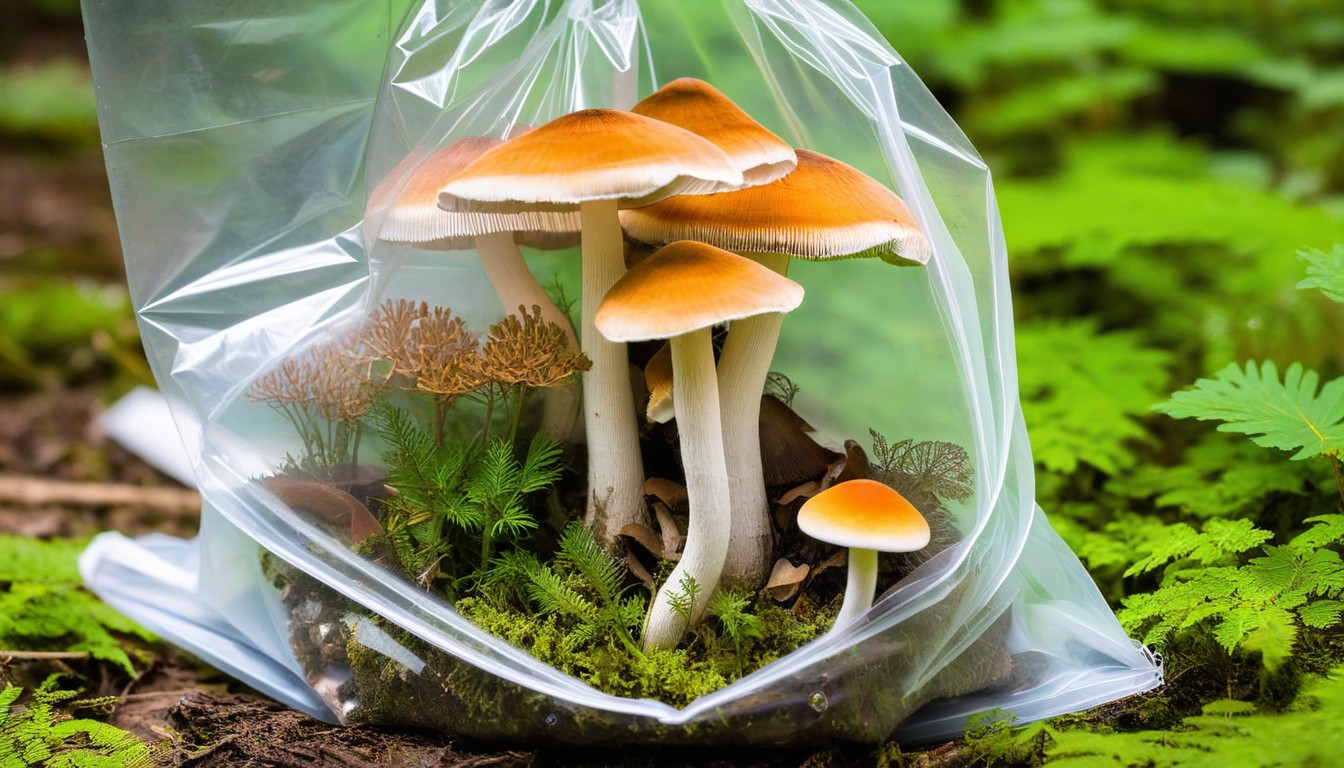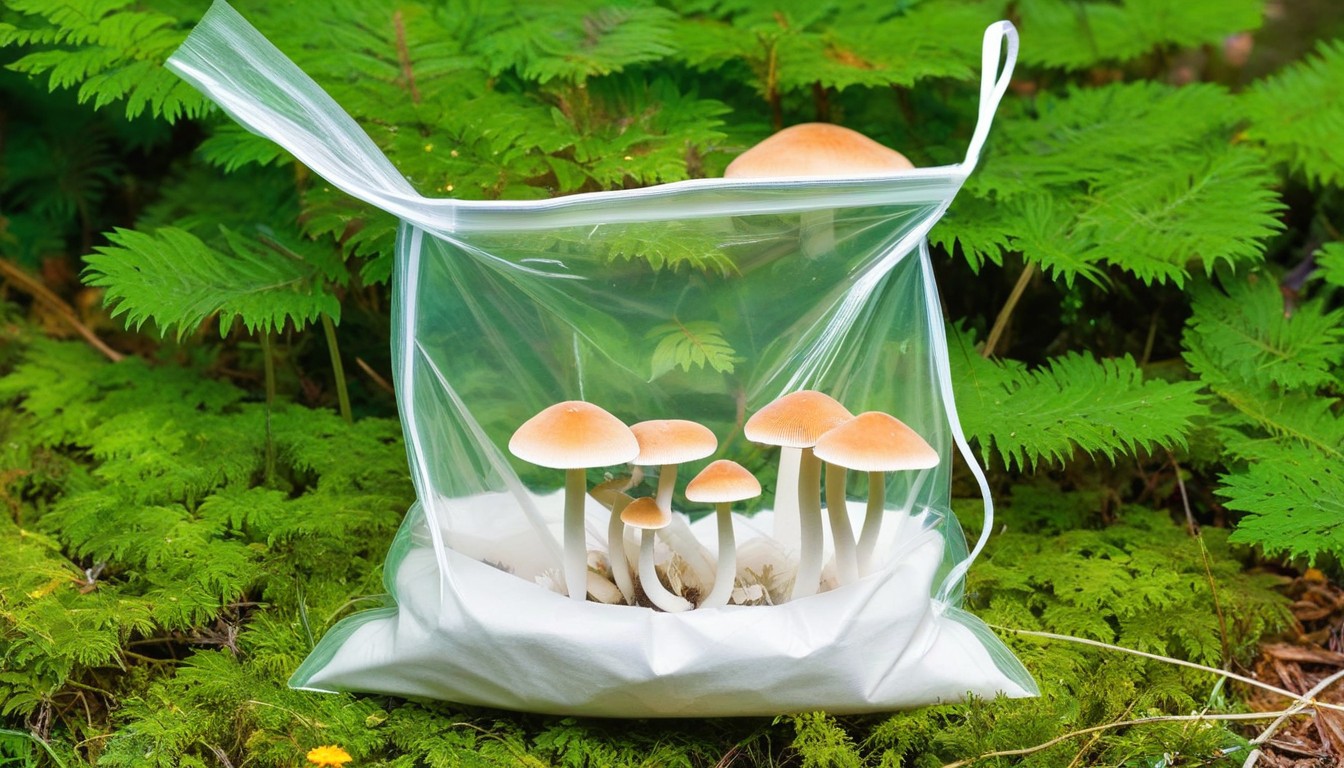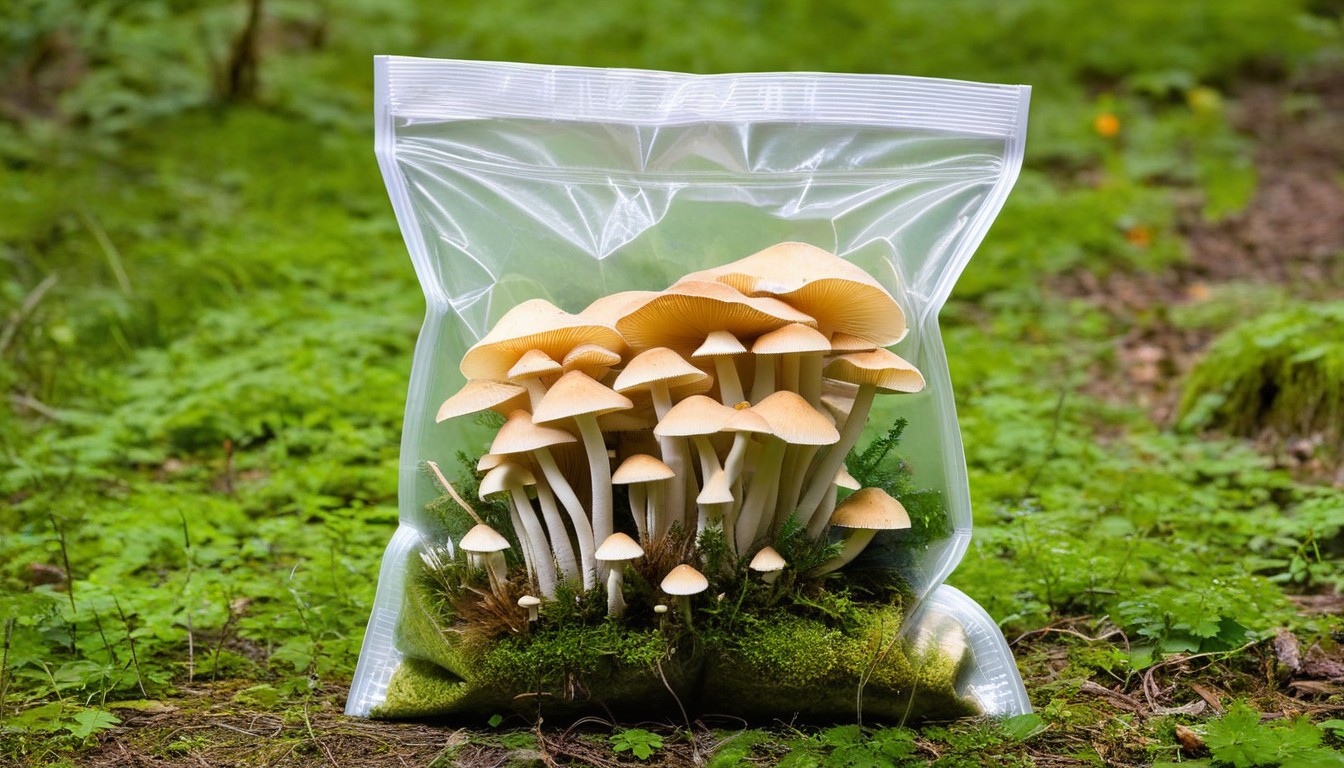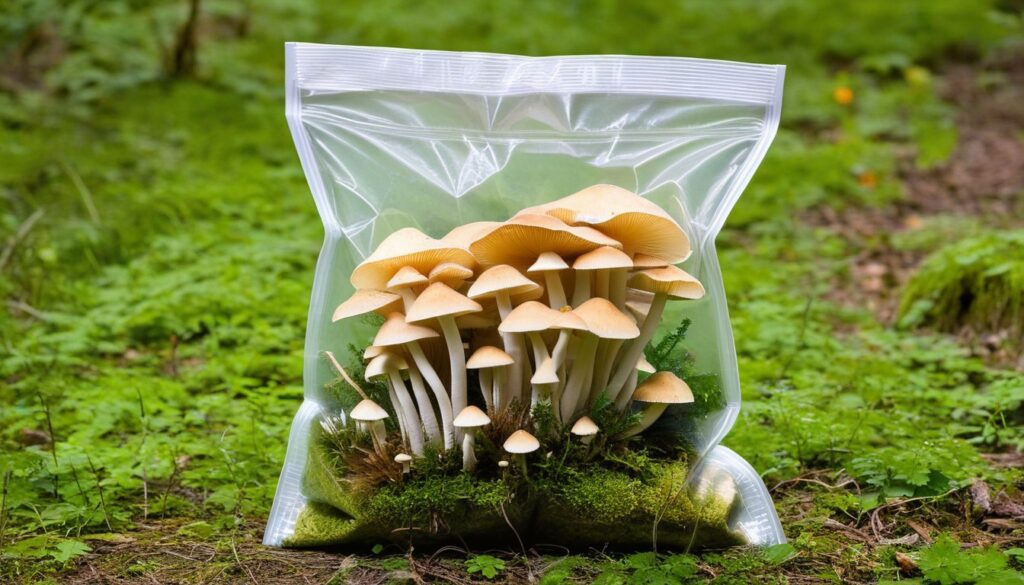Are you interested in cultivating your own indoor garden of delicious and nutritious mushrooms? Growing mushrooms in bags is a simple and accessible way to get started. In this comprehensive guide, we will walk you through the process step by step, from selecting the right mushroom variety to harvesting your first crop.
With easy maintenance and space-saving benefits, this method of mushroom cultivation is gaining popularity among gardeners. Whether you are a seasoned gardener or new to the world of indoor gardening, growing mushrooms in bags is a rewarding and satisfying hobby.
Key Takeaways:
- Learn the advantages of growing mushrooms in bags
- Discover the essential equipment needed for bag cultivation
- Explore different mushroom varieties suited for bag growing
- Understand how to prepare the substrate and inoculate the bags
- Find out how to maintain optimal growing conditions and troubleshoot common problems
Why Choose to Grow Mushrooms In Bags
Are you looking to start an indoor garden but lack the space or the time? Or maybe you’re just a big fan of mushrooms and want to cultivate your own delicious and savory fungi? If so, growing mushrooms in bags might be the perfect solution for you. In this section, we’ll explore the advantages of this method and why it’s becoming more and more popular among indoor gardeners.
Advantages of Growing Mushrooms In Bags
- Easy Maintenance: Unlike traditional gardening, growing mushrooms in bags requires minimal maintenance. Once you’ve mixed the substrate and inoculated the bags, all you need to do is keep them in a cool and dark place, occasionally misting them to maintain humidity levels. No need to worry about weeding, watering, or pests!
- Space-saving: Mushroom bags can be grown indoors in small spaces, making them a perfect option for apartment dwellers or those who lack outdoor garden space.
- Better Control: With bag growing, you have more control over the growing conditions. You can monitor and adjust humidity levels, temperature, and light to ensure the optimal conditions for healthy mushroom growth.
- Versatility: Mushrooms growing in bags have a smaller carbon footprint compared to other crops, and therefore, can be grown without the need for harsh chemicals or fertilizers. This makes them a great choice for anyone who wants to grow food naturally without harming the environment.
“Growing mushrooms in bags is an accessible and rewarding endeavor for any indoor gardener.”
Now that you know the advantages of growing mushrooms in bags, let’s dive into the specifics and explore the types of mushrooms that are suited for this method.
Selecting the Right Mushroom Varieties
Not all mushrooms are suitable for growing in bags. To ensure a successful harvest, it’s essential to choose the right mushroom varieties that are well-suited to bag cultivation. Here are some popular mushroom species that thrive in bags:
|
Mushroom Variety |
Characteristics |
Flavor Profile |
|---|---|---|
|
Shiitake |
Fast-growing, adaptable to different growing conditions |
Earthy, smoky |
|
Oyster |
Easy to grow, high yield |
Nutty, savory |
|
Lion’s Mane |
Unique appearance, medicinal properties |
Sweet, seafood-like |
|
Reishi |
Medicinal properties, slow-growing |
Bitter, woody |
These mushroom varieties are widely available and can be purchased from specialty mushroom suppliers or garden stores. Before purchasing, ensure that the supplier’s products are high-quality and healthy. You can also experiment with other mushroom species and see how they perform in bags.
Tip: When choosing mushroom varieties, consider your personal taste preferences, as well as their adaptability to your growing conditions.
Next, it’s important to consider the type of substrate required for each mushroom variety. Different species thrive in different substrates, so it’s essential to match the right mushroom with the right substrate.
For example, shiitake mushrooms usually grow best in hardwood sawdust, while oyster mushrooms favor straw or coffee grounds. Lion’s mane mushrooms require a more complex substrate mixture, which includes hardwood sawdust, bran, and gypsum.
Tip: Do some research on the specific substrate needs of your chosen mushroom variety to ensure optimal growth and yield.
Choosing the right mushroom variety is a crucial step in the bag growing process. With the right species and substrate, you’ll be well on your way to a successful harvest of delicious, nutritious mushrooms.
Gathering the Necessary Equipment

Before you can start growing mushrooms in bags, it’s essential to gather the right equipment. Here’s a list of the basic equipment needed to get started:
|
Equipment |
Description |
|---|---|
|
Mushroom bags |
The size and quantity of bags will depend on how many mushrooms you plan to grow. |
|
Substrate |
The material that will act as the growing medium for your mushrooms. Common substrates include sawdust, straw, and coffee grounds. |
|
Spores or spawn |
The mushroom “seed” that you will use to inoculate the substrate. |
|
Pressure cooker or sterilization equipment |
Used to sterilize the substrate before inoculation to prevent contamination. |
|
Spray bottle |
You’ll need this to mist the bags occasionally to maintain proper humidity levels. |
|
Thermometer and hygrometer |
These tools will help you monitor the temperature and humidity levels in your growing area. |
It’s essential to note that the quality of your equipment can significantly affect the success of your mushroom growing. Invest in high-quality bags, substrate, and other essential tools to ensure your mushrooms grow healthy and strong.
Preparing the Substrate

When it comes to growing mushrooms in bags, the substrate plays a critical role in providing the essential nutrients and environment for mushroom growth. Here’s how to prepare the substrate:
- Select the right ingredients: The substrate typically consists of a combination of organic materials, such as straw, sawdust, and/or coffee grounds. Choose high-quality, fresh ingredients and avoid any that may have been contaminated with mold or bacteria.
- Mix the substrate: Once you have your ingredients, mix them together in a large container or bag. The exact proportions of each component will depend on the specific mushroom variety you’re growing, so be sure to follow a reliable recipe or guide.
- Sterilize the substrate: To prevent contamination with unwanted bacteria or fungi, you’ll need to sterilize the substrate before inoculating it with mushroom spores or mycelium. There are different ways to sterilize the substrate, such as using a pressure cooker, a steam bath, or chemical sterilization agents. Follow the recommended instructions for your chosen sterilization method to ensure effective sterilization.
Pro Tips:
“Avoid using ingredients that contain high amounts of salt, oil, or other additives, as they can interfere with mushroom growth. Also, keep in mind that different mushroom varieties have different substrate preferences and may require specific substrates to grow successfully.”
Inoculating the Bags
Once you have prepared the substrate, it is time to inoculate the bags with mushroom spores or mycelium. Here are the steps to follow:
- Clean your workspace: Before beginning, make sure your workspace is clean and free of contaminants that could harm your mushrooms.
- Prepare your spores or mycelium: You can use spores or mycelium to inoculate your bags. If you are using spores, you will need to first grow them on agar or another medium. If you are using mycelium, you can purchase it from a supplier or grow it yourself.
- Add the spores or mycelium to the substrate: Wearing gloves, add the spores or mycelium to the substrate in the bag. If using spores, sprinkle them evenly over the substrate. If using mycelium, break it up into small pieces and add it to the substrate.
- Mix the substrate: Mix the substrate and spores or mycelium thoroughly to ensure even distribution.
- Seal the bag: Seal the bag with a twist tie or heat sealer to prevent contamination.
- Incubate the bag: Place the bag in a warm, dark place to incubate. The ideal temperature for most mushroom species is around 75-80°F.
- Wait for colonization: After a few days or weeks, you should start to see the substrate colonizing with mycelium. Be patient and avoid disturbing the bag.
Once the substrate is fully colonized, the mushrooms will begin to fruit. At this point, you can move the bag to your growing area and begin to cultivate your mushrooms.
Inoculating your bags is a crucial step in the mushroom growing process. Take your time and follow the steps carefully to ensure a successful harvest.”
Creating the Ideal Growing Conditions

Creating the perfect environment for your mushroom bags is key to a successful harvest. Let’s take a closer look at the ideal growing conditions for your mushroom bags:
Temperature
The ideal temperature for mushroom growth is between 65-75°F (18-24°C). However, the exact temperature range can vary slightly depending on the mushroom variety. To maintain a consistent temperature, use a thermometer to monitor the air in your growing area. You can also use a heating pad or space heater to regulate the temperature if necessary.
Humidity
Humidity is another crucial factor to consider. Most mushroom varieties thrive in a humid environment with 80-90% relative humidity. To maintain the proper moisture level, mist your mushroom bags daily with a spray bottle filled with clean water. You can also use a humidifier to help regulate humidity levels in the air.
Light
Unlike plants, mushrooms do not require light to grow. In fact, exposure to light can actually stunt their growth. However, it’s still essential to provide some ambient light in the room for your own safety and convenience. A low-wattage bulb or natural light from a window will suffice.
Airflow
Proper airflow is crucial for preventing the growth of mold and other harmful bacteria. Make sure the room where you are growing your mushrooms is well-ventilated. You can use a fan to circulate the air, but make sure it’s not blowing directly on the mushroom bags. High-speed air currents can dry out the substrate and prevent the mushrooms from growing.
pH Level
Lastly, it’s important to monitor the pH level of your substrate. Most mushroom varieties prefer a slightly acidic environment with a pH range of 5.0-6.5. You can test the pH using an inexpensive soil test kit available at your local gardening store.
“Maintaining the proper growing conditions is essential for the successful cultivation of your mushroom bags.”
Remember to regularly monitor and adjust your growing conditions to ensure your mushrooms are healthy and thriving. With the right environment and proper care, you’ll soon be enjoying a bountiful harvest of delicious mushrooms!
Maintaining and Caring for Your Mushroom Bags
To ensure healthy and bountiful mushroom growth, it’s essential to properly maintain and care for your bags. Follow these tips to keep your mushroom bags thriving:
Watering
Proper watering is crucial in maintaining mushroom bags. Overwatering can cause the substrate to become waterlogged and lead to contamination. Underwatering can cause the bags to dry out, stunting growth.
To water your bags, mist them regularly with a spray bottle. A fine mist will provide the necessary moisture without saturating the substrate.
Monitoring for Pests and Diseases
Pest and disease control is vital to the success of your mushroom growing venture. Regularly inspect your bags for signs of contamination, mold, or pests.
If you notice any issues, remove the affected bags immediately to prevent the spread of contamination.
Addressing Issues
Despite best efforts, issues may arise during the mushroom growing process. Here are some common problems and their solutions:
|
Issue |
Solution |
|---|---|
|
Slow growth |
Check the temperature and humidity levels. Ensure that the bags are receiving enough light. |
|
Contamination |
Remove the affected bags immediately to prevent the spread of contamination. Review your sterilization process and adjust as necessary. |
|
Mold |
Remove the affected bags immediately to prevent the spread of mold. Review your sterilization process and adjust as necessary. |
Harvesting and Storing Your Mushrooms
Once your mushrooms are ready to harvest, be sure to do it correctly to preserve their quality.
To harvest, gently twist and pull the mushroom caps or cut them at the stem base. Avoid yanking or pulling the entire mushroom cluster as it can cause damage to the substrate.
Proper storage is also essential. Store your mushrooms in a paper bag or on a plate covered with a damp cloth in the refrigerator for up to a week.
By following these tips for maintaining and caring for your mushroom bags, you can enjoy a continuous harvest of delicious and nutritious mushrooms.
Harvesting and Storing Your Mushrooms

Harvesting your mushrooms at the right time is crucial for optimal flavor, appearance, and nutrition. Here are the steps to ensure a successful harvest:
- Wait until the mushroom caps have fully opened and the veil underneath has started to tear. This is typically when the caps have reached their maximum size.
- Gently twist and pull the mushroom from the bag, being careful not to damage the surrounding substrate or other mushrooms nearby.
- Trim any remaining substrate from the base of the mushroom using a sanitized knife or scissors.
- Once harvested, store your mushrooms in a paper bag or container lined with paper towels to absorb excess moisture. Avoid using plastic bags, which can cause the mushrooms to become slimy.
- Store your mushrooms in the refrigerator for up to one week. For longer storage, you can also freeze your mushrooms in an airtight container or freezer bag.
It’s important to note that some mushroom varieties may require slightly different harvesting and storing methods. Be sure to research specific instructions for the type of mushroom you are growing.
Troubleshooting Common Mushroom Growing Issues
Despite your best efforts, you may encounter some problems during the mushroom growing process. Here are some common mushroom growing issues and how to fix them:
Mold
Mold can occur when there is too much moisture in the growing environment. To fix this issue, reduce the humidity levels by increasing ventilation, using a dehumidifier, or moving the bags to a drier location.
Contamination
Contamination can occur when unwanted bacteria or fungi invade the growing environment. To prevent contamination, make sure to sterilize all equipment and materials before use. If contamination occurs, dispose of the affected bags and start again with fresh materials.
Slow Growth
Slow growth can occur when the growing environment is not optimal. Make sure that the temperature and humidity levels are within the recommended range for your mushroom variety. You may also need to increase ventilation or adjust the lighting if necessary.
Small Fruiting Bodies
Small fruiting bodies can occur when the bags are overcrowded or the growing conditions are not ideal. Make sure to space out the bags properly and monitor the temperature and humidity levels to ensure optimal growth.
Poor Yield
Poor yield can occur for a variety of reasons, including poor substrate quality or incorrect growing conditions. Make sure that you are using high-quality substrate and that the temperature and humidity levels are within the recommended range for your mushroom variety. You may also need to adjust lighting or fertilization if necessary.
Expanding Your Mushroom Growing Skills
Congratulations, you’ve successfully grown mushrooms in bags! Now it’s time to take your skills to the next level and try some new techniques. Here are some ways to expand your mushroom growing skills:
Experiment with Different Mushroom Varieties
Now that you’ve mastered growing popular varieties like button or oyster mushrooms, why not try something new? There are countless mushroom species out there with unique textures, flavors, and nutritional profiles. Consider experimenting with specialty varieties like shiitake, lion’s mane, or enoki mushrooms to broaden your palate and growing skills.
Try Advanced Techniques
Once you’re comfortable with the basics, you can experiment with more advanced growing techniques like agar plate culturing, liquid culture, or grain spawn. These methods can offer more control over the growing process and yield better results, but they also require more specialized equipment and expertise.
Join a Mycology Community
Joining a mycology community or club can provide a wealth of knowledge and support for your mushroom growing endeavors. You can connect with fellow growers, share tips and techniques, and get advice on troubleshooting any issues that arise. Plus, it’s a great way to meet other like-minded individuals and foster a sense of community around mushroom cultivation.
Consider Starting a Small-Scale Business
If you’re passionate about mushroom growing and have a knack for business, consider turning your hobby into a small-scale business. You can sell your mushrooms at local farmers’ markets or to restaurants and gourmet food shops. Just be sure to research any applicable regulations and obtain any necessary permits or licenses before getting started.
Expanding your mushroom growing skills can be a fun and rewarding way to continue your journey into the world of mycology. Whether you try new varieties, advanced techniques, join a community, or even start a business, there are endless possibilities for growth and learning. Happy growing!
Conclusion
In conclusion, growing mushrooms in bags is a fulfilling and accessible indoor gardening activity that can yield delicious and nutritious results. With this guide, you have gained essential knowledge, techniques, and insights required to successfully cultivate your own mushroom garden in bags.
By choosing to grow mushrooms in bags, you can enjoy the benefits of a space-saving, low-maintenance, and controlled environment to cultivate your favorite mushroom varieties. With little effort and investment, you can create a sustainable source of fresh mushrooms for your meals or even start a small-scale business.
Happy Growing!
So, roll up your sleeves, gather your supplies and substrate, and embark on this thrilling journey of growing mushrooms in the comfort of your own home. Remember to follow the steps and techniques outlined in this guide, experiment with different varieties, and seek further knowledge to expand your mushroom growing skills.
Thank you for reading, and we wish you a happy growing and harvesting experience!
FAQ
Why should I choose to grow mushrooms in bags?
Growing mushrooms in bags offers several advantages, including easy maintenance, space-saving benefits, and better control over growing conditions. It’s a convenient and efficient method for cultivating delicious and nutritious mushrooms.
How do I select the right mushroom varieties for bag cultivation?
Not all mushrooms thrive in bags, so it’s important to choose the right species. In our guide, we’ll provide an overview of popular mushroom varieties suited for bag growing, highlighting their unique characteristics and flavor profiles.
What equipment do I need for growing mushrooms in bags?
To get started, you’ll need essential tools such as bags, substrate, sterilization equipment, and more. We’ll outline the necessary equipment, where to find them, and what to look for when making purchases.
How do I prepare the substrate for bag growing?
The substrate is a crucial element in mushroom cultivation. We’ll guide you through the process of selecting the right ingredients and sterilization methods to create an optimal environment for mushroom growth.
How do I inoculate the bags with mushroom spores or mycelium?
Once the substrate is ready, it’s time to inoculate the bags. We’ll explain different inoculation techniques, walk you through the step-by-step process, and provide tips for ensuring successful colonization.
What are the ideal growing conditions for mushrooms in bags?
Discover the optimal temperature, humidity, and light requirements for growing mushrooms in bags. We’ll also discuss common challenges and provide solutions for creating the ideal environment for healthy mushroom growth.
How do I maintain and care for my mushroom bags?
Like any garden, mushroom bags require regular attention and care. Learn how to properly maintain your bags, including watering, monitoring for pests and diseases, and addressing any issues that may arise during the growing process.
How do I harvest and store my mushrooms?
When the time comes, it’s essential to harvest your mushrooms at the right moment for peak flavor and nutrition. We’ll guide you through the harvesting process and provide tips on proper handling and storage techniques to preserve the quality of your harvest.
What are some common mushroom growing issues and how do I troubleshoot them?
Even with careful cultivation, issues may arise during the mushroom growing process. In this section, we’ll discuss common problems and offer troubleshooting solutions. From mold and contamination to slow growth, you’ll find practical tips to overcome these challenges.
How can I expand my mushroom growing skills?
Once you’ve mastered the basics of growing mushrooms in bags, you may want to explore further. We’ll suggest ways to expand your skills, including advanced techniques, experimenting with different varieties, and even starting a small-scale business.

